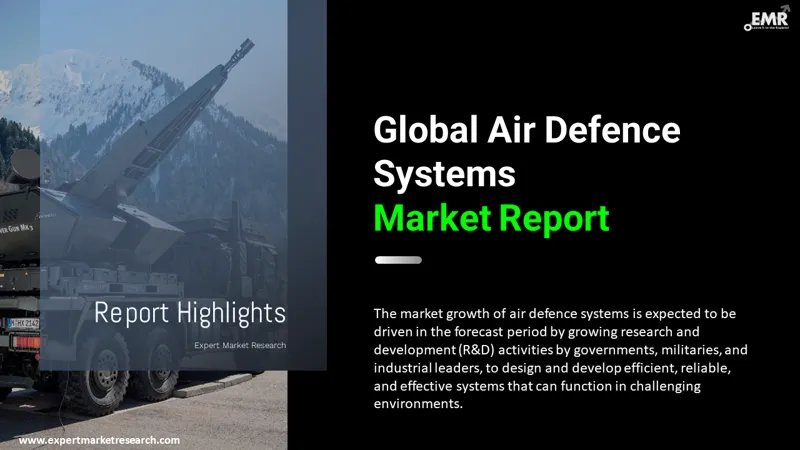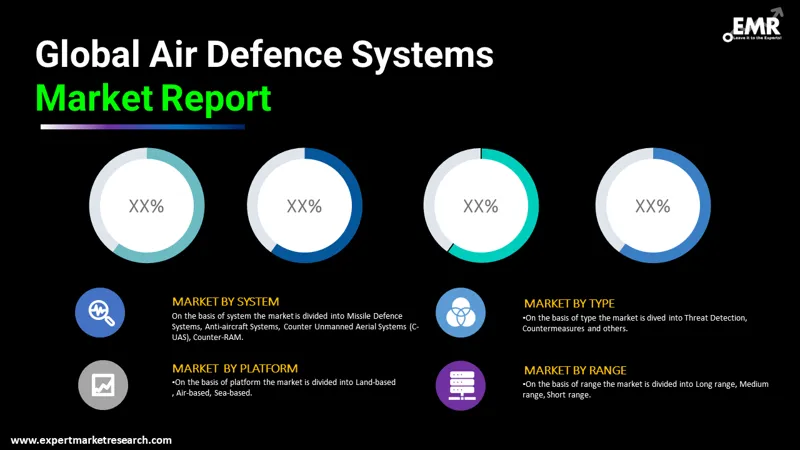
Consumer Insights
Uncover trends and behaviors shaping consumer choices today
Procurement Insights
Optimize your sourcing strategy with key market data
Industry Stats
Stay ahead with the latest trends and market analysis.
The global air defence systems market is expected to grow in the forecast period of 2026-2035 at a CAGR of 6.80%
Base Year
Historical Period
Forecast Period
Compound Annual Growth Rate
6.8%
2026-2035
*this image is indicative*
The rising incorporation of counter unmanned aerial systems (C-UAV) by security forces, coupled with the increasing sophistication of the product to mitigate the threats posed by unauthorised unmanned aerial vehicles, is driving the segment’s growth. C-UAS are well-equipped with advanced technologies such as RF jamming, radar, radiofrequency (RF), and acoustic and combined sensors, among others. This makes the product efficient in the detection, tracking, and identification of a drone in a commercial or non-commercial area. Over the forecast period, the improvement of UAVs in terms of size, weight, and cheaper production, are likely to increase the risk of UAV swarm attacks, which is anticipated to propel the demand for C-UAVs. Moreover, the incorporation of technological advancements such as lasers and high-power microwaves in C-UAVs are likely to bolster investments in C-UAVs by major military powers and fuel the growth of the air defence systems market in the forecast period.

Read more about this report - REQUEST FREE SAMPLE COPY IN PDF
The United States of America is one of the highest spenders on military and defence and possesses missile defence technologies such as PATRIOT Missile System, Terminal High Altitude Area Defense (THAAD), and the Avenger Air Defense System. In addition, the strong foothold of major defence manufacturing companies in the region is anticipated to be a key driving factor in the market. The United States is also one of the major air defence technology providers to countries such as Ukraine and Taiwan, which is also bolstering the market growth in North America. Meanwhile, the Asia Pacific region is anticipated to offer lucrative opportunities to the air defence systems market owing to the increasing investments and favourable government policies aimed towards setting up indigenous manufacturing. In countries like India, the Make in India scheme by the government is likely to accelerate the development of missile defence systems and drive the market in the coming years.
Air defence systems include defensive technologies intended to block air threats by intercepting guided missiles and destroying aircraft launched by the enemy. In conventional warfare, air defence systems play a crucial role in minimising the damage caused by short, medium, or long-range threats. The systems identify, analyse, and track the motion of the trajectory launch and kill them.
Market Breakup by System
Market Breakup by Platform
Market Breakup by Type
Market Breakup by Range
Market Breakup by Region

Read more about this report - REQUEST FREE SAMPLE COPY IN PDF
The air defence systems market is being driven by the increasing adoption of air defence systems in the military and defence sector to battle the emerging spectrum of threats posed by air-attack weapons, ranging from cruise missiles to ballistic missiles. Air defence is a key technology capable of protecting crucial assets and responding timely to the threats, due to which the deployment of air defence systems is surging. Moreover, the systems offer monitoring and information sharing, which make the threat navigation clearer, hence furthering their demand.
In the forecast period, the growing research and development (R&D) activities by governments, militaries, and industrial leaders to design and develop efficient, reliable, and effective air defence systems that can function in challenging environments are anticipated to propel the market growth. Furthermore, the air defence systems market is likely to be invigorated by the rising military expenditure in emerging economies, the surging geopolitical tensions, the growing risk of modern warfare, and the increasing international cooperation aimed at impending terrorism.
The report gives a detailed analysis of the following key players in the global air defence systems market, covering their competitive landscape, capacity, and latest developments like mergers, acquisitions, and investments, expansions of capacity, and plant turnarounds:
The comprehensive EMR report provides an in-depth assessment of the market based on the Porter's five forces model along with giving a SWOT analysis.




*While we strive to always give you current and accurate information, the numbers depicted on the website are indicative and may differ from the actual numbers in the main report. At Expert Market Research, we aim to bring you the latest insights and trends in the market. Using our analyses and forecasts, stakeholders can understand the market dynamics, navigate challenges, and capitalize on opportunities to make data-driven strategic decisions.*
Get in touch with us for a customized solution tailored to your unique requirements and save upto 35%!
The global air defence systems market is estimated to grow at a CAGR of 6.80% between 2026 and 2035.
The major regions in the market are North America, Latin America, the Middle East and Africa, Europe, and the Asia Pacific.
The major drivers of the market include the increasing adoption of air defence system in the military and defence to battle the emerging spectrum of threats posed by air-attack weapons, rising military expenditure of various sovereign nations, and technological advancements of drones.
The growing research and development (R&D) activities to design and develop efficient, reliable, and effective air defence systems, the growing threat of terrorism, and the increasing geopolitical tensions are likely to aid the market.
Missile defence systems, anti-aircraft systems, counter unmanned aerial systems (C-UAS), and counter-RAM are the different systems in the market.
Land-based, air-based, and sea-based are the major platforms of air defence systems.
Threat detection and countermeasures are the significant types of air defence systems in the market.
Long range, medium range, and short range are the various ranges of air defence systems.
The major players in the market are Raytheon Technologies Corporation, Rheinmetall AG, Thales Group, Lockheed Martin Corporation, and Saab AB, among others.
Explore our key highlights of the report and gain a concise overview of key findings, trends, and actionable insights that will empower your strategic decisions.
| REPORT FEATURES | DETAILS |
| Base Year | 2025 |
| Historical Period | 2019-2025 |
| Forecast Period | 2026-2035 |
| Scope of the Report |
Historical and Forecast Trends, Industry Drivers and Constraints, Historical and Forecast Market Analysis by Segment:
|
| Breakup by System |
|
| Breakup by Platform |
|
| Breakup by Type |
|
| Breakup by Range |
|
| Breakup by Region |
|
| Market Dynamics |
|
| Competitive Landscape |
|
| Companies Covered |
|
| Report Price and Purchase Option | Explore our purchase options that are best suited to your resources and industry needs. |
| Delivery Format | Delivered as an attached PDF and Excel through email, with an option of receiving an editable PPT, according to the purchase option. |
Single User License
One User
USD 3,999
USD 3,599
tax inclusive*
Datasheet
One User
USD 2,499
USD 2,249
tax inclusive*
Five User License
Five User
USD 4,999
USD 4,249
tax inclusive*
Corporate License
Unlimited Users
USD 5,999
USD 5,099
tax inclusive*
*Please note that the prices mentioned below are starting prices for each bundle type. Kindly contact our team for further details.*
Flash Bundle
Small Business Bundle
Growth Bundle
Enterprise Bundle
*Please note that the prices mentioned below are starting prices for each bundle type. Kindly contact our team for further details.*
Flash Bundle
Number of Reports: 3
20%
tax inclusive*
Small Business Bundle
Number of Reports: 5
25%
tax inclusive*
Growth Bundle
Number of Reports: 8
30%
tax inclusive*
Enterprise Bundle
Number of Reports: 10
35%
tax inclusive*
How To Order

Select License Type
Choose the right license for your needs and access rights.

Click on ‘Buy Now’
Add the report to your cart with one click and proceed to register.

Select Mode of Payment
Choose a payment option for a secure checkout. You will be redirected accordingly.
Gain insights to stay ahead and seize opportunities.

Get insights & trends for a competitive edge.

Track prices with detailed trend reports.

Analyse trade data for supply chain insights.

Leverage cost reports for smart savings

Enhance supply chain with partnerships.

Connect For More Information
Our expert team of analysts will offer full support and resolve any queries regarding the report, before and after the purchase.
Our expert team of analysts will offer full support and resolve any queries regarding the report, before and after the purchase.
We employ meticulous research methods, blending advanced analytics and expert insights to deliver accurate, actionable industry intelligence, staying ahead of competitors.
Our skilled analysts offer unparalleled competitive advantage with detailed insights on current and emerging markets, ensuring your strategic edge.
We offer an in-depth yet simplified presentation of industry insights and analysis to meet your specific requirements effectively.
Share